| Listing 1 - 10 of 18 | << page >> |
Sort by
|
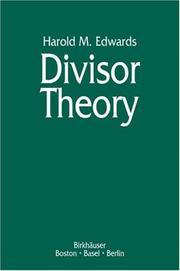
ISBN: 0817634487 081764976X 0817649778 9780817634483 Year: 1990 Publisher: Boston, Mass. Birkhäuser
Abstract | Keywords | Export | Availability | Bookmark
 Loading...
Loading...Choose an application
- Reference Manager
- EndNote
- RefWorks (Direct export to RefWorks)
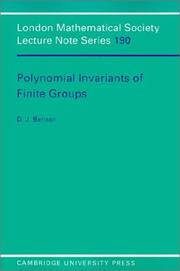
ISBN: 1139884999 1107366941 1107371597 1107362032 1107370329 1299404669 1107364485 0511565801 9781107362031 0521458862 9780521458863 9780511565809 Year: 1993 Volume: 190 Publisher: Cambridge New York Cambridge University Press
Abstract | Keywords | Export | Availability | Bookmark
 Loading...
Loading...Choose an application
- Reference Manager
- EndNote
- RefWorks (Direct export to RefWorks)
This is the first book to deal with invariant theory and the representations of finite groups. By restricting attention to finite groups Dr Benson is able to avoid recourse to the technical machinery of algebraic groups, and he develops the necessary results from commutative algebra as he proceeds. Thus the book should be accessible to graduate students. In detail, the book contains an account of invariant theory for the action of a finite group on the ring of polynomial functions on a linear representation, both in characteristic zero and characteristic p. Special attention is paid to the role played by pseudoreflections, which arise because they correspond to the divisors in the polynomial ring which ramify over the invariants. Also included is a new proof by Crawley-Boevey and the author of the Carlisle-Kropholler conjecture. This volume will appeal to all algebraists, but especially those working in representation theory, group theory, and commutative or homological algebra.
Invariants. --- Finite groups. --- Divisor theory. --- Categories (Mathematics) --- Ideals (Algebra) --- Modules (Algebra) --- Groups, Finite --- Group theory --- Groups (Mathematics)
Book
ISBN: 052134056X 9780521340564 9780511566004 9780521091671 Year: 1989 Volume: 90 Publisher: Cambridge Cambridge University press
Abstract | Keywords | Export | Availability | Bookmark
 Loading...
Loading...Choose an application
- Reference Manager
- EndNote
- RefWorks (Direct export to RefWorks)
511.3 --- Distribution (Probability theory) --- Divisor theory --- Categories (Mathematics) --- Ideals (Algebra) --- Modules (Algebra) --- Distribution functions --- Frequency distribution --- Characteristic functions --- Probabilities --- 511.3 Analytical, additive and other number-theory problems. Diophantine approximations --- Analytical, additive and other number-theory problems. Diophantine approximations --- Number theory --- Divisor theory.
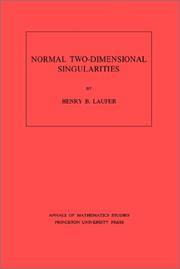
ISBN: 069108100X 1400881749 9780691081007 Year: 1971 Volume: 71 Publisher: Princeton (N.J.): Princeton university press
Abstract | Keywords | Export | Availability | Bookmark
 Loading...
Loading...Choose an application
- Reference Manager
- EndNote
- RefWorks (Direct export to RefWorks)
A survey, thorough and timely, of the singularities of two-dimensional normal complex analytic varieties, the volume summarizes the results obtained since Hirzebruch's thesis (1953) and presents new contributions. First, the singularity is resolved and shown to be classified by its resolution; then, resolutions are classed by the use of spaces with nilpotents; finally, the spaces with nilpotents are determined by means of the local ring structure of the singularity.
Algebraic geometry --- Analytic spaces --- SINGULARITIES (Mathematics) --- 512.76 --- Singularities (Mathematics) --- Geometry, Algebraic --- Spaces, Analytic --- Analytic functions --- Functions of several complex variables --- Birational geometry. Mappings etc. --- Analytic spaces. --- Singularities (Mathematics). --- 512.76 Birational geometry. Mappings etc. --- Birational geometry. Mappings etc --- Analytic function. --- Analytic set. --- Analytic space. --- Automorphism. --- Bernhard Riemann. --- Big O notation. --- Calculation. --- Chern class. --- Codimension. --- Coefficient. --- Cohomology. --- Compact Riemann surface. --- Complex manifold. --- Computation. --- Connected component (graph theory). --- Continuous function. --- Contradiction. --- Coordinate system. --- Corollary. --- Covering space. --- Dimension. --- Disjoint union. --- Divisor. --- Dual graph. --- Elliptic curve. --- Elliptic function. --- Embedding. --- Existential quantification. --- Factorization. --- Fiber bundle. --- Finite set. --- Formal power series. --- Hausdorff space. --- Holomorphic function. --- Homeomorphism. --- Homology (mathematics). --- Intersection (set theory). --- Intersection number (graph theory). --- Inverse limit. --- Irreducible component. --- Isolated singularity. --- Iteration. --- Lattice (group). --- Line bundle. --- Linear combination. --- Line–line intersection. --- Local coordinates. --- Local ring. --- Mathematical induction. --- Maximal ideal. --- Meromorphic function. --- Monic polynomial. --- Nilpotent. --- Normal bundle. --- Open set. --- Parameter. --- Plane curve. --- Pole (complex analysis). --- Power series. --- Presheaf (category theory). --- Projective line. --- Quadratic transformation. --- Quantity. --- Riemann surface. --- Riemann–Roch theorem. --- Several complex variables. --- Submanifold. --- Subset. --- Tangent bundle. --- Tangent space. --- Tensor algebra. --- Theorem. --- Topological space. --- Transition function. --- Two-dimensional space. --- Variable (mathematics). --- Zero divisor. --- Zero of a function. --- Zero set. --- Variétés complexes --- Espaces analytiques
Book
ISBN: 0691080291 1322884943 069164554X 1400869293 9781400869299 9780691618548 0691618542 Year: 1970 Publisher: Princeton, N.J.
Abstract | Keywords | Export | Availability | Bookmark
 Loading...
Loading...Choose an application
- Reference Manager
- EndNote
- RefWorks (Direct export to RefWorks)
This book is a sequel to Lectures on Complex Analytic Varieties: The Local Paranwtrization Theorem (Mathematical Notes 10, 1970). Its unifying theme is the study of local properties of finite analytic mappings between complex analytic varieties; these mappings are those in several dimensions that most closely resemble general complex analytic mappings in one complex dimension. The purpose of this volume is rather to clarify some algebraic aspects of the local study of complex analytic varieties than merely to examine finite analytic mappings for their own sake.Originally published in 1970.The Princeton Legacy Library uses the latest print-on-demand technology to again make available previously out-of-print books from the distinguished backlist of Princeton University Press. These editions preserve the original texts of these important books while presenting them in durable paperback and hardcover editions. The goal of the Princeton Legacy Library is to vastly increase access to the rich scholarly heritage found in the thousands of books published by Princeton University Press since its founding in 1905.
Complex analysis --- Analytic spaces --- Mathematics --- Physical Sciences & Mathematics --- Calculus --- Spaces, Analytic --- Analytic functions --- Functions of several complex variables --- Algebra homomorphism. --- Algebraic curve. --- Algebraic extension. --- Algebraic surface. --- Algebraic variety. --- Analytic continuation. --- Analytic function. --- Associated prime. --- Atlas (topology). --- Automorphism. --- Bernhard Riemann. --- Big O notation. --- Branch point. --- Change of variables. --- Characterization (mathematics). --- Codimension. --- Coefficient. --- Cohomology. --- Complete intersection. --- Complex analysis. --- Complex conjugate. --- Complex dimension. --- Complex number. --- Connected component (graph theory). --- Corollary. --- Critical point (mathematics). --- Diagram (category theory). --- Dimension (vector space). --- Dimension. --- Disjoint union. --- Divisor. --- Equation. --- Equivalence class. --- Exact sequence. --- Existential quantification. --- Finitely generated module. --- Geometry. --- Hamiltonian mechanics. --- Holomorphic function. --- Homeomorphism. --- Homological dimension. --- Homomorphism. --- Hypersurface. --- Ideal (ring theory). --- Identity element. --- Induced homomorphism. --- Inequality (mathematics). --- Injective function. --- Integral domain. --- Invertible matrix. --- Irreducible component. --- Isolated singularity. --- Isomorphism class. --- Jacobian matrix and determinant. --- Linear map. --- Linear subspace. --- Local ring. --- Mathematical induction. --- Mathematics. --- Maximal element. --- Maximal ideal. --- Meromorphic function. --- Modular arithmetic. --- Module (mathematics). --- Module homomorphism. --- Monic polynomial. --- Monomial. --- Neighbourhood (mathematics). --- Noetherian. --- Open set. --- Parametric equation. --- Parametrization. --- Permutation. --- Polynomial ring. --- Polynomial. --- Power series. --- Quadratic form. --- Quotient module. --- Regular local ring. --- Removable singularity. --- Ring (mathematics). --- Ring homomorphism. --- Row and column vectors. --- Scalar multiplication. --- Scientific notation. --- Several complex variables. --- Sheaf (mathematics). --- Special case. --- Subalgebra. --- Submanifold. --- Subset. --- Summation. --- Surjective function. --- Taylor series. --- Theorem. --- Three-dimensional space (mathematics). --- Topological space. --- Vector space. --- Weierstrass preparation theorem. --- Zero divisor. --- Fonctions de plusieurs variables complexes --- Variétés complexes
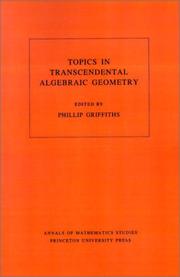
ISBN: 0691083355 0691083398 140088165X Year: 1984 Publisher: Princeton (N.J.): Princeton university press
Abstract | Keywords | Export | Availability | Bookmark
 Loading...
Loading...Choose an application
- Reference Manager
- EndNote
- RefWorks (Direct export to RefWorks)
The description for this book, Topics in Transcendental Algebraic Geometry. (AM-106), Volume 106, will be forthcoming.
Geometry, Algebraic. --- Hodge theory. --- Torelli theorem. --- Géométrie algébrique --- Théorie de Hodge --- Geometry, Algebraic --- Hodge theory --- Torelli theorem --- 512.7 --- Torelli's theorem --- Curves, Algebraic --- Jacobians --- Complex manifolds --- Differentiable manifolds --- Homology theory --- Algebraic geometry --- Geometry --- Algebraic geometry. Commutative rings and algebras --- 512.7 Algebraic geometry. Commutative rings and algebras --- Géométrie algébrique --- Théorie de Hodge --- Abelian integral. --- Algebraic curve. --- Algebraic cycle. --- Algebraic equation. --- Algebraic geometry. --- Algebraic integer. --- Algebraic structure. --- Algebraic surface. --- Arithmetic genus. --- Arithmetic group. --- Asymptotic analysis. --- Automorphism. --- Base change. --- Bilinear form. --- Bilinear map. --- Cohomology. --- Combinatorics. --- Commutative diagram. --- Compactification (mathematics). --- Complete intersection. --- Complex manifold. --- Complex number. --- Computation. --- Deformation theory. --- Degeneracy (mathematics). --- Differentiable manifold. --- Dimension (vector space). --- Divisor (algebraic geometry). --- Divisor. --- Elliptic curve. --- Elliptic surface. --- Equation. --- Exact sequence. --- Fiber bundle. --- Function (mathematics). --- Fundamental class. --- Geometric genus. --- Geometry. --- Hermitian symmetric space. --- Hodge structure. --- Homology (mathematics). --- Homomorphism. --- Homotopy. --- Hypersurface. --- Intersection form (4-manifold). --- Intersection number. --- Irreducibility (mathematics). --- Isomorphism class. --- Jacobian variety. --- K3 surface. --- Kodaira dimension. --- Kronecker's theorem. --- Kummer surface. --- Kähler manifold. --- Lie algebra bundle. --- Lie algebra. --- Linear algebra. --- Linear algebraic group. --- Line–line intersection. --- Mathematical induction. --- Mathematical proof. --- Mathematics. --- Modular arithmetic. --- Module (mathematics). --- Moduli space. --- Monodromy matrix. --- Monodromy theorem. --- Monodromy. --- Nilpotent orbit. --- Normal function. --- Open set. --- Period mapping. --- Permutation group. --- Phillip Griffiths. --- Point at infinity. --- Pole (complex analysis). --- Polynomial. --- Projective space. --- Pullback (category theory). --- Quadric. --- Regular singular point. --- Resolution of singularities. --- Riemann–Roch theorem for surfaces. --- Scientific notation. --- Set (mathematics). --- Special case. --- Spectral sequence. --- Subgroup. --- Submanifold. --- Surface of general type. --- Surjective function. --- Tangent bundle. --- Theorem. --- Topology. --- Transcendental number. --- Vector space. --- Zariski topology. --- Zariski's main theorem.
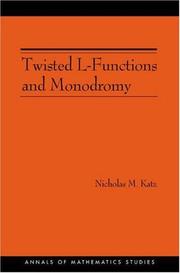
ISBN: 1282820893 9786612820892 1400824885 069109151X 0691091501 9781400824885 9780691091501 9780691091518 9781282820890 6612820896 Year: 2009 Volume: 150 Publisher: Princeton, NJ
Abstract | Keywords | Export | Availability | Bookmark
 Loading...
Loading...Choose an application
- Reference Manager
- EndNote
- RefWorks (Direct export to RefWorks)
For hundreds of years, the study of elliptic curves has played a central role in mathematics. The past century in particular has seen huge progress in this study, from Mordell's theorem in 1922 to the work of Wiles and Taylor-Wiles in 1994. Nonetheless, there remain many fundamental questions where we do not even know what sort of answers to expect. This book explores two of them: What is the average rank of elliptic curves, and how does the rank vary in various kinds of families of elliptic curves? Nicholas Katz answers these questions for families of ''big'' twists of elliptic curves in the function field case (with a growing constant field). The monodromy-theoretic methods he develops turn out to apply, still in the function field case, equally well to families of big twists of objects of all sorts, not just to elliptic curves. The leisurely, lucid introduction gives the reader a clear picture of what is known and what is unknown at present, and situates the problems solved in this book within the broader context of the overall study of elliptic curves. The book's technical core makes use of, and explains, various advanced topics ranging from recent results in finite group theory to the machinery of l-adic cohomology and monodromy. Twisted L-Functions and Monodromy is essential reading for anyone interested in number theory and algebraic geometry.
L-functions. --- Monodromy groups. --- Functions, L --- -L-functions. --- Group theory --- -Number theory --- L-functions --- Monodromy groups --- Abelian variety. --- Absolute continuity. --- Addition. --- Affine space. --- Algebraically closed field. --- Ambient space. --- Average. --- Betti number. --- Birch and Swinnerton-Dyer conjecture. --- Blowing up. --- Codimension. --- Coefficient. --- Computation. --- Conjecture. --- Conjugacy class. --- Convolution. --- Critical value. --- Differential geometry of surfaces. --- Dimension (vector space). --- Dimension. --- Direct sum. --- Divisor (algebraic geometry). --- Divisor. --- Eigenvalues and eigenvectors. --- Elliptic curve. --- Equation. --- Equidistribution theorem. --- Existential quantification. --- Factorization. --- Finite field. --- Finite group. --- Finite set. --- Flat map. --- Fourier transform. --- Function field. --- Functional equation. --- Goursat's lemma. --- Ground field. --- Group representation. --- Hyperplane. --- Hypersurface. --- Integer matrix. --- Integer. --- Irreducible component. --- Irreducible polynomial. --- Irreducible representation. --- J-invariant. --- K3 surface. --- L-function. --- Lebesgue measure. --- Lefschetz pencil. --- Level of measurement. --- Lie algebra. --- Limit superior and limit inferior. --- Minimal polynomial (field theory). --- Modular form. --- Monodromy. --- Morphism. --- Numerical analysis. --- Orthogonal group. --- Percentage. --- Polynomial. --- Prime number. --- Probability measure. --- Quadratic function. --- Quantity. --- Quotient space (topology). --- Representation theory. --- Residue field. --- Riemann hypothesis. --- Root of unity. --- Scalar (physics). --- Set (mathematics). --- Sheaf (mathematics). --- Subgroup. --- Summation. --- Symmetric group. --- System of imprimitivity. --- Theorem. --- Trivial representation. --- Zariski topology.
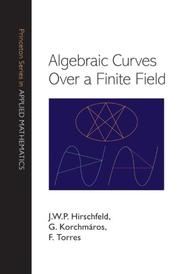
ISBN: 1400847419 9781400847419 1306988608 9781306988605 9781400847426 1400847427 0691096791 9780691096797 9780691096797 Year: 2013 Publisher: Princeton, NJ
Abstract | Keywords | Export | Availability | Bookmark
 Loading...
Loading...Choose an application
- Reference Manager
- EndNote
- RefWorks (Direct export to RefWorks)
This book provides an accessible and self-contained introduction to the theory of algebraic curves over a finite field, a subject that has been of fundamental importance to mathematics for many years and that has essential applications in areas such as finite geometry, number theory, error-correcting codes, and cryptology. Unlike other books, this one emphasizes the algebraic geometry rather than the function field approach to algebraic curves. The authors begin by developing the general theory of curves over any field, highlighting peculiarities occurring for positive characteristic and requiring of the reader only basic knowledge of algebra and geometry. The special properties that a curve over a finite field can have are then discussed. The geometrical theory of linear series is used to find estimates for the number of rational points on a curve, following the theory of Stöhr and Voloch. The approach of Hasse and Weil via zeta functions is explained, and then attention turns to more advanced results: a state-of-the-art introduction to maximal curves over finite fields is provided; a comprehensive account is given of the automorphism group of a curve; and some applications to coding theory and finite geometry are described. The book includes many examples and exercises. It is an indispensable resource for researchers and the ideal textbook for graduate students.
Curves, Algebraic. --- Finite fields (Algebra) --- Modular fields (Algebra) --- Algebra, Abstract --- Algebraic fields --- Galois theory --- Modules (Algebra) --- Algebraic curves --- Algebraic varieties --- Abelian group. --- Abelian variety. --- Affine plane. --- Affine space. --- Affine variety. --- Algebraic closure. --- Algebraic curve. --- Algebraic equation. --- Algebraic extension. --- Algebraic function. --- Algebraic geometry. --- Algebraic integer. --- Algebraic number field. --- Algebraic number theory. --- Algebraic number. --- Algebraic variety. --- Algebraically closed field. --- Applied mathematics. --- Automorphism. --- Birational invariant. --- Characteristic exponent. --- Classification theorem. --- Clifford's theorem. --- Combinatorics. --- Complex number. --- Computation. --- Cyclic group. --- Cyclotomic polynomial. --- Degeneracy (mathematics). --- Degenerate conic. --- Divisor (algebraic geometry). --- Divisor. --- Dual curve. --- Dual space. --- Elliptic curve. --- Equation. --- Fermat curve. --- Finite field. --- Finite geometry. --- Finite group. --- Formal power series. --- Function (mathematics). --- Function field. --- Fundamental theorem. --- Galois extension. --- Galois theory. --- Gauss map. --- General position. --- Generic point. --- Geometry. --- Homogeneous polynomial. --- Hurwitz's theorem. --- Hyperelliptic curve. --- Hyperplane. --- Identity matrix. --- Inequality (mathematics). --- Intersection number (graph theory). --- Intersection number. --- J-invariant. --- Line at infinity. --- Linear algebra. --- Linear map. --- Mathematical induction. --- Mathematics. --- Menelaus' theorem. --- Modular curve. --- Natural number. --- Number theory. --- Parity (mathematics). --- Permutation group. --- Plane curve. --- Point at infinity. --- Polar curve. --- Polygon. --- Polynomial. --- Power series. --- Prime number. --- Projective plane. --- Projective space. --- Quadratic transformation. --- Quadric. --- Resolution of singularities. --- Riemann hypothesis. --- Scalar multiplication. --- Scientific notation. --- Separable extension. --- Separable polynomial. --- Sign (mathematics). --- Singular point of a curve. --- Special case. --- Subgroup. --- Sylow theorems. --- System of linear equations. --- Tangent. --- Theorem. --- Transcendence degree. --- Upper and lower bounds. --- Valuation ring. --- Variable (mathematics). --- Vector space.
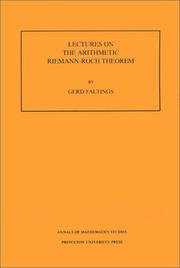
ISBN: 0691087717 0691025444 1400882478 Year: 2016 Volume: vol 127 Publisher: Princeton, NJ : Princeton University Press,
Abstract | Keywords | Export | Availability | Bookmark
 Loading...
Loading...Choose an application
- Reference Manager
- EndNote
- RefWorks (Direct export to RefWorks)
The arithmetic Riemann-Roch Theorem has been shown recently by Bismut-Gillet-Soul. The proof mixes algebra, arithmetic, and analysis. The purpose of this book is to give a concise introduction to the necessary techniques, and to present a simplified and extended version of the proof. It should enable mathematicians with a background in arithmetic algebraic geometry to understand some basic techniques in the rapidly evolving field of Arakelov-theory.
Algebraic geometry --- Algebraïsche meetkunde --- Geometry [Algebraic ] --- Géométrie algébrique --- Meetkunde [Algebraïsche ] --- Riemann-Roch theorema's --- Riemann-Roch thoerems --- Theoremes de Riemann-Roch --- Geometry, Algebraic. --- Riemann-Roch theorems. --- Theorems, Riemann-Roch --- Algebraic functions --- Geometry, Algebraic --- Geometry --- Addition. --- Adjoint. --- Alexander Grothendieck. --- Algebraic geometry. --- Analytic torsion. --- Arakelov theory. --- Asymptote. --- Asymptotic expansion. --- Asymptotic formula. --- Big O notation. --- Cartesian coordinate system. --- Characteristic class. --- Chern class. --- Chow group. --- Closed immersion. --- Codimension. --- Coherent sheaf. --- Cohomology. --- Combination. --- Commutator. --- Computation. --- Covariant derivative. --- Curvature. --- Derivative. --- Determinant. --- Diagonal. --- Differentiable manifold. --- Differential form. --- Dimension (vector space). --- Divisor. --- Domain of a function. --- Dual basis. --- E6 (mathematics). --- Eigenvalues and eigenvectors. --- Embedding. --- Endomorphism. --- Exact sequence. --- Exponential function. --- Generic point. --- Heat kernel. --- Injective function. --- Intersection theory. --- K-group. --- Levi-Civita connection. --- Line bundle. --- Linear algebra. --- Local coordinates. --- Mathematical induction. --- Morphism. --- Natural number. --- Neighbourhood (mathematics). --- Parameter. --- Projective space. --- Pullback (category theory). --- Pullback (differential geometry). --- Pullback. --- Riemannian manifold. --- Riemann–Roch theorem. --- Self-adjoint operator. --- Smoothness. --- Sobolev space. --- Stochastic calculus. --- Summation. --- Supertrace. --- Theorem. --- Transition function. --- Upper half-plane. --- Vector bundle. --- Volume form.
Book

ISBN: 128305180X 9786613051806 1400839009 9781400839001 9780691142012 0691142017 9780691142029 0691142025 Year: 2011 Publisher: Princeton, NJ
Abstract | Keywords | Export | Availability | Bookmark
 Loading...
Loading...Choose an application
- Reference Manager
- EndNote
- RefWorks (Direct export to RefWorks)
"Modular forms are tremendously important in various areas of mathematics, from number theory and algebraic geometry to combinatorics and lattices. Their Fourier coefficients, with Ramanujan's tau-function as a typical example, have deep arithmetic significance. Prior to this book, the fastest known algorithms for computing these Fourier coefficients took exponential time, except in some special cases. The case of elliptic curves (Schoof's algorithm) was at the birth of elliptic curve cryptography around 1985. This book gives an algorithm for computing coefficients of modular forms of level one in polynomial time. For example, Ramanujan's tau of a prime number P can be computed in time bounded by a fixed power of the logarithm of P. Such fast computation of Fourier coefficients is itself based on the main result of the book: the computation, in polynomial time, of Galois representations over finite fields attached to modular forms by the Langlands program. Because these Galois representations typically have a nonsolvable image, this result is a major step forward from explicit class field theory, and it could be described as the start of the explicit Langlands program. The computation of the Galois representations uses their realization, following Shimura and Deligne, in the torsion subgroup of Jacobian varieties of modular curves. The main challenge is then to perform the necessary computations in time polynomial in the dimension of these highly nonlinear algebraic varieties. Exact computations involving systems of polynomial equations in many variables take exponential time. This is avoided by numerical approximations with a precision that suffices to derive exact results from them. Bounds for the required precision--in other words, bounds for the height of the rational numbers that describe the Galois representation to be computed--are obtained from Arakelov theory. Two types of approximations are treated: one using complex uniformization and another one using geometry over finite fields. The book begins with a concise and concrete introduction that makes its accessible to readers without an extensive background in arithmetic geometry. And the book includes a chapter that describes actual computations"-- "This book represents a major step forward from explicit class field theory, and it could be described as the start of the 'explicit Langlands program'"--
Galois modules (Algebra) --- Class field theory. --- Algebraic number theory --- Galois module structure (Algebra) --- Galois's modules (Algebra) --- Modules (Algebra) --- Arakelov invariants. --- Arakelov theory. --- Fourier coefficients. --- Galois representation. --- Galois representations. --- Green functions. --- Hecke operators. --- Jacobians. --- Langlands program. --- Las Vegas algorithm. --- Lehmer. --- Peter Bruin. --- Ramanujan's tau function. --- Ramanujan's tau-function. --- Ramanujan's tau. --- Riemann surfaces. --- Schoof's algorithm. --- Turing machines. --- algorithms. --- arithmetic geometry. --- arithmetic surfaces. --- bounding heights. --- bounds. --- coefficients. --- complex roots. --- computation. --- computing algorithms. --- computing coefficients. --- cusp forms. --- cuspidal divisor. --- eigenforms. --- finite fields. --- height functions. --- inequality. --- lattices. --- minimal polynomial. --- modular curves. --- modular forms. --- modular representation. --- modular representations. --- modular symbols. --- nonvanishing conjecture. --- p-adic methods. --- plane curves. --- polynomial time algorithm. --- polynomial time algoriths. --- polynomial time. --- polynomials. --- power series. --- probabilistic polynomial time. --- random divisors. --- residual representation. --- square root. --- square-free levels. --- tale cohomology. --- torsion divisors. --- torsion.
| Listing 1 - 10 of 18 | << page >> |
Sort by
|

 Search
Search Feedback
Feedback About UniCat
About UniCat  Help
Help News
News